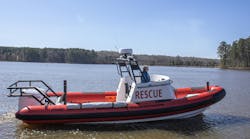As an emergency responder, your agency has probably been dealing with technical rescue at one level or another for years, even if you didn't realize it. Within the last ten years, line-of-duty injuries and fatalities involving special operations prompted the development of standards for technical rescue training and operations. In addition, standards were developed for professional qualifications of rescue technicians.
Personal discussions with agency representatives around the nation revealed to me that not everyone understands NFPA 1670 (Training and Operations) and 1006 (Professional Qualifications), nor do they understand how these standards relate to their activities. I found that many agencies charged with responding to technical rescue were either going all out to meet these standards or doing nothing at all. Some were under the impression that 1670 was a document that covered qualifications, when it actually discusses training and operations. NFPA 1006 refers specifically to technician qualifications.
According to NFPA 1670 , each agency with the responsibility to respond to technical rescues shall establish levels of operational capability needed to conduct operations at technical rescue incidents. These capabilities are based on a community hazard analysis, risk assessment, training level of personnel, and availability of internal and external resources. Furthermore, agencies are required to establish written standard operating procedures consistent with one of the following operational levels:
(b) Operations. This level represents the capability of hazard recognition, equipment use, and techniques necessary to safely and effectively support and participate in a technical rescue incident. This level can involve search, rescue, and recovery operations, but usually operations are carried out under the supervision of technician-level personnel.
(c) Technician. This level represents the capability of hazard recognition, equipment use, and techniques necessary to safely and effectively coordinate, perform, and supervise a technical rescue incident. This level can involve search, rescue, and recovery operations.
Technical rescue involves separate disciplines such as vehicle and machinery extrication, rope, confined spaces, trench and structural collapses, water and dive operations, and wilderness situations. Since EMS, Law Enforcement, and Emergency Management agencies respond to these incidents in conjunction with the Fire Department, they should be preparing to at least the Awareness level.
NFPA 1670 goes on to state:
- Operational procedures shall not exceed the agency's identified level of capability.
- Agencies shall provide for training and continuing education in the responsibilities that are commensurate with the identified operational capability of each member.
- Minimum training for all members shall be at the awareness level. Members expected to perform at a higher operational level shall be trained to that level.
What does this mean for emergency service providers? If you have a duty to respond to incidents involving special operations, you need to determine the level of response you are compelled to provide, plan for it, train for it, and allocate resources to handle it at that level. In South Carolina, the fire department generally has taken on the responsibility for mitigating technical incidents, or at least managing them until the appropriate resources can be obtained. Some EMS agencies in South Carolina currently respond to technical rescues as the principal provider. Your own individual state laws will dictate who has the ultimate responsibility for response.
Occasionally, rescuers believed that 1670 required the immediate purchase of a bunch of expensive equipment and the assembly of technician level teams. There is, however, nothing wrong with agencies training personnel and operating at the Awareness level, so long as they arrange for the response of external resources if available for that discipline. Departments need to consider the needs of their community and prepare their teams to those levels.
Our organization, for example, has determined that we are only going to train personnel to the Awareness level for Wilderness. We have an urban environment and training our personnel to the operations or technician levels would be counterproductive. Training personnel for ice or mountain rescue on Hilton Head Island would likewise be unrealistic and unnecessary.
Another problem I see with some of these well-intentioned agencies (our own included) is that we all want to do too much without developing a good basic structure. Emphasis of Awareness issues assure that critical elements of the scene will be managed appropriately by all personnel, not just the technical rescue team. Safety issues are addressed, resource needs are identified, and the tech team can do the work instead of managing the scene.
Does NFPA 1670 then, require agencies to be able to handle all technical rescues? Awareness levels in technical rescue are similar to those for hazardous materials response in that organizations should be able to at least recognize that a technical rescue emergency exists, develop an incident management and accountability system, make the scene safe, and summon appropriate resources.
Your agency's commitment to respond to a technical rescue assumes that you have accepted a duty to act. The level of response is dependent upon the scope of your organization, and then only subsequent to analysis of your community hazard assessment. A well-done hazard assessment should help your organization determine the frequency or likelihood of need and the potential financial and social impact on the community. This analysis then assists you in creating a plan to obtain the necessary resources.
Since the issues at hand are awareness issues, I have chosen to point out the keys to developing a program based on this level of response. These are the nuts and bolts of any operation and particularly technical rescue, for if you fail to address these basic needs, your program is pretty much doomed to fail. The consequences of failure can be injuries and fatalities to civilians and rescuers, as well as liability. Short of that, the inability to function smoothly and seamlessly is simply embarrassing and causes your agency to be seen in an unfavorable light.
The key points of a successful Awareness level technical rescue program will include:
- Identification of Hazards - In order to determine which hazards exist in your community, you must conduct a hazard assessment. Which events are likely to occur? Which incidents may not be as frequent, but are inevitable, such as acts of nature? What disciplines are going to be required to handle an emergency of this nature?
- Forming a Plan - After consideration of the hazard analysis, what level of response will meet the needs of the hazard analysis? Do you currently have the resources (trained personnel, equipment, apparatus, and procedures) to meet these needs? What reasonable budget do you think you can sell to your controlling authority for these needs? If you consider volunteers or external resources, what is the likelihood they will respond? (They may have other obligations in disasters). Can you develop a long-term plan and phase it in? Remember that in the case of a multi-discipline hazard like a major building collapse, even if you are the largest provider in the State, your organization is not likely going to be able to handle it on your own. In these cases you should consider entering into regional mutual aid agreements or discussing options with the county or state emergency management divisions.
- Obtaining Resources - Using the developed plan, determine whom you have on staff that can help to plug in the parts. Consider that your team needs to meet the identified level of response and you are going to need the appropriate tools and materials for the situation. Develop internal and external resource lists. Identify how to contact increased resources, staging for more, and plan for expansion. Insure that the organization is meeting OSHA needs as well, especially in the confined space and trench disciplines.
- Training Personnel - All personnel with the potential to respond or arrive first on a technical rescue incident need to have Awareness training. The training should be specific to hazard as possible and should discuss your organization's approach to the problem. Developing training using your hazard analysis, your plan, and your SOGs develops ownership in the plan and will facilitate user comfort when things get bad. Use this stage to identify and develop your team leaders. Consider also asking contractors and utilities to attend and obtain certification when you are conducting Awareness training on structural collapse, confined space, or trench issues. By doing so, your organization educates the people who will likely be first involved in these situations and it also gives your employees perspective as to how these situations are handled outside the fire service.
- Implementing the Plan - Formally announce the operational status of the plan by issuing a press release and notifying your employees. This formal introduction gives the plan a starting point and makes all the players aware that this is how things will be done from here on out. The press release gets the public involved and sets your agency up to discuss additional funding, if that is necessary for the next stages of the project. This method of implementation also provides a forum to present your current capabilities and future plans to outside agencies like mutual aid departments, utilities and contractors.
- Testing and Re-evaluating - Finally, schedule and conduct drills to test the personnel, to insure the plan is being used. If the plan is not being used, remediate the personnel or solve the problems that prevent the plan from working properly.
Arrival at the scene requires your agency to either deal with the situation or ignore it. I don't anticipate anyone in the fire service planning to ignore the situation, so my suggestion is to plan ahead to develop or seek the resources to handle these emergencies when they occur. Identification of potential liabilities, development of a strategy to handle the incident, educating your personnel, and putting a plan into action will at least see you and your colleagues through to another incident safely.





